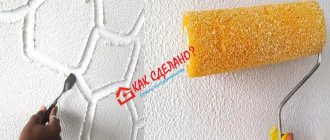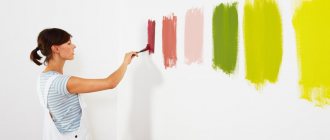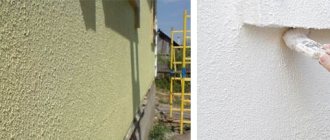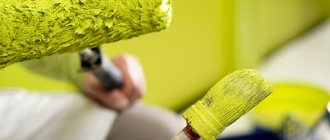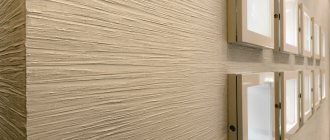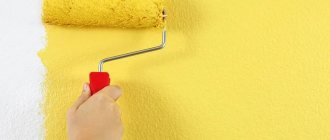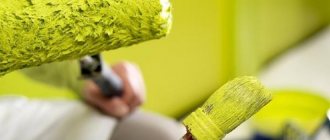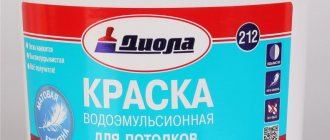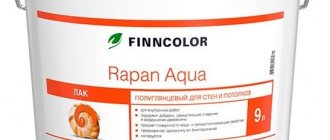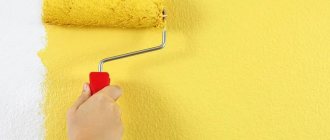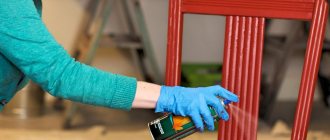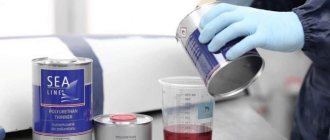Sand paint composition
The main ingredients included in the composition are binders, solvent and antiseptic additives that prevent the formation of fungus and mold.
To create an interesting texture, crushed shells, quartz sand, mother-of-pearl chips or other mineral components are added to the paint mixture. Such additives allow you to achieve a textured effect.
Sand paints are thicker, so they can mask minor wall defects. This saves time and money on plastering surfaces.
Features of decorative plaster under sand
The plaster contains fine river sand, which makes this finishing material unique. Designers often prefer plaster rather than paint, because it has a number of advantages:
Decorative plaster lasts a long time, protects walls from fungus and is suitable for any walls.
Sand plaster can be used to finish any surface. It works equally well on concrete, brick, drywall and wood. It is used when they want to hide unevenness and defects of the wall, make it textured and embossed.
This plaster is not afraid of moisture. It can be used to decorate walls in the kitchen or bathroom. And even after wet cleaning, the surface will not lose its shine.
Finishing material is also used to protect walls from fungus and mold. Under a layer of sand plaster, the wall breathes, and germs and bacteria do not accumulate on it. To ensure that such a problem does not arise, it is recommended to plaster the walls with a mixture that includes quartz. Plaster with river sand grains will last for many years, provided that all the rules for its operation are followed. It is suitable for decorating interior walls of any style. There is a huge variety of designs, colors and textures on the market, among which you can find an option that is suitable specifically for your apartment.
On the modern market, decorative plaster is presented in a huge assortment. It differs in color, texture and is suitable for interior decoration in any style.
Main types
Decorative sand-effect wall paint is produced in a wide range of shades. On sale are not only compositions of the main color palette, but also paints that imitate a metal surface - bronze, silver, gold. If desired, you can order the white paint to be tinted in the shade you need.
There are two main types of paint mixtures:
- Mother of pearl. They contain reflective components that give the coating a pearlescent shine. If you look at the surface of the walls from different angles, the paint may change shade. If you liked this option, then perhaps you will also like silk paint for walls.
- Matte. No fillers that reflect light are added to such mixtures. This look is great for decorating walls in soothing colors. The surface has a rough texture.
The high strength qualities of sand paints make it possible to use them for both interior and exterior work. The considerable cost of a facade painted with such compositions is paid off by the long service life of the coating and its magnificent appearance.
What is quartz primer
Quartz primer with the addition of sand is a building compound used to improve adhesion. From the name we can tell that the main component is quartz sand, due to which roughness is formed.
Quartz primer with the addition of sand is a building compound used to improve adhesion.
Composition and characteristics
Since the primer should increase the surface roughness without changing the strength and aesthetics, the following components were included in the composition:
- Latex composites - due to this part, the material is securely fixed to the surface. Additionally, the composition may contain acrylic and acrylic-latex additives;
- Bactericidal components – to increase durability. Any surface can be subject to an increase in moisture levels so that there is no risk of fungal infection - this component is added to the composition of many modern materials;
- Resins – to achieve homogeneity;
- Dye - pigment is an assistant for the builder when applying it to the wall.
A primer with sand perfectly protects the surface from the appearance of fungus. It is used for finishing basement floors and external surfaces. You can even apply this type of material to old paint, because sometimes it is not always possible to completely clear it of metal before transforming it. The scope of application is quite wide; you can familiarize yourself with all the nuances below.
A primer with sand perfectly protects the surface from the appearance of fungus.
Scope of application and restrictions on use
Experts recommend using this type of coating in the following cases:
- If you have to correct the finishing of leveled walls. The compound is applied to small areas that have already been polished. After it hardens, you can safely correct small errors using finishing plaster;
- Processing of monolithic walls - they are so smooth that not every material will fit on them. Quartz soil with sand for walls will help cope with this difficult task;
- To create a translucent effect on walls.
Many craftsmen use quartz primer to reduce material consumption when doing decorative plaster work. How profitable this is - there is no exact data.
Many craftsmen use quartz primer to reduce material consumption when doing decorative plaster work.
How to apply
The application technique is not too complicated, but requires care and careful adherence to the manufacturer's instructions. First you need to prepare the surface.
Preparation consists of several operations:
- Cleaning the base from dust, dirt, grease and oil stains. If this is not done, then the adhesion (adhesion) of the paint to the surface may be insufficient, which will significantly deteriorate the strength qualities of the decorative layer.
- Removing crumbling plaster. Durable plaster does not need to be removed.
- Plastering the surface. Both cement and gypsum compositions can be used. Gypsum plaster dries faster; it is advisable to use it if finishing work needs to be completed in a short time.
- Puttying. At this stage, minor defects in the walls are repaired and the surface is finally leveled. Final leveling is carried out using a sanding block.
- Application of deep penetration primer. The primer is applied to clean, smooth walls.
Proper preparation of the base will ensure a long service life of the decorative coating.
Methods for applying paint with sand are chosen depending on what texture you want to get as a result. Usually the paint is sold ready for use, only sometimes it needs to be diluted a little with water.
The first layer is done using a paint roller, fur or thread. The layer thickness varies from 1 to 3 mm.
There are variations of this stage among different masters. Most often, the base is applied with non-textured paint, tinted in a color close to decorative paint. Some craftsmen simply tint the primer.
The second layer, which actually gives the effect, is applied with a brush after the first has dried. Then the coating, preventing it from drying out, is smoothed with special tools, most often with a brush - dispersing sand over the surface, decorating it. If the walls should have a pronounced relief, you can use a roller with a fine structure.
If you haven't worked with sugar paint before, try doing the whole process on a small test surface first. How the master does it in the video.
The painted surface dries for at least a day; you can decorate the walls with interior items only after it has completely dried.
What effect can you achieve?
"Shagreen skin"
It's easy to get. A distinctive point is the ability to use on uneven surfaces. When alternative methods become powerless, plaster with the “Shagreen skin” effect can come to the rescue. Minor roughness is hidden due to the non-uniform pattern. Sometimes even a smooth effect is created.
Plasters with this effect are applied as a final layer. Other options are not considered, since it will not look beautiful under other layers of finishing coatings. Depending on the characteristics of the room, stylistic design, lighting and area, the selection of paint, its quantity, and unusual pattern is carried out.
"Sackcloth"
- To achieve this effect, you need to prime and putty the surface. You will need a new medium-sized roller onto which the composition will be applied.
- When the putty dries, begin mixing the mass.
Take finishing putty, water and PVA glue. All these ingredients will give plasticity to the cladding and quickly adhere to the wall. Tip To get the burlap effect, you need to apply the prepared solution to the wall in even portions and strictly in a vertical direction. - The brush makes vertical furrows by evenly fixing the tool. The appearance of wavy areas must be avoided.
- After the first layer has completely dried, a second one is applied, but in a horizontal direction. Layers also need to be applied in stripes. Here furrows are made again, but horizontally.
- After drying, the putty is passed over the surface with sandpaper - all irregularities and bumps will be eliminated.
- The last stage on the way to obtaining the desired design is priming and painting the walls.
The beautiful relief surface looks very good against the background of any interior.
"Sand Dunes"
“Sand dunes” are created with a brush. The drawing is associated with the desert. The ways to create a masterpiece come down to the following steps:
- Cross-shaped strokes are applied: the hands are moved from side to side. Place the brush at a gentle angle, and use a spatula as a tool.
- Allow the applied layers to dry and at the same time examine the surface for possible defects. If omissions are found, then you should immediately apply a new layer to the defect.
- Blend with a clean brush. Performed to give a careful appearance. Therefore, you should only use a new brush so as not to leave any traces of dirt.
- Increase density. Perform this step as needed. “Sand swirls” are complemented by another final layer of plaster, on which similar work is carried out. Allow this finishing layer to dry thoroughly and inspect it at the time of the gaps. All unfinished or missed points are corrected.
In the first 2–3 days, the pattern can be adjusted, since the adhesion of the wall to the putty occurs over the course of several days. After a week's break, this may not be possible. All work should be carried out clearly within the specified time frame and at a certain interval to correct defects.
"Sand Wind"
A pattern similar to the first one, differing only in that it is performed according to a chaotic swirl application pattern. Circular movements are added to the cross movements
It is important to notice the style and assertiveness of movements in order to recreate the desired visual image
Advice
The material should be scattered over the entire surface of the wall, including the recesses, if any. The brush should not be dipped into the container too much, nor should it be overloaded with material, in order to prevent it from becoming tacky and excessively piling up.
The resulting pattern depends on the application technique. The easiest way is to spray. You need to dip a stiff brush into the mixture, and then hit the board with the bristles at a short distance from the wall. Splashes will fly onto the surface, and after drying a pattern will appear.
It is more difficult to work with a spatula. But without it it will not be possible to create a surface with the effect of a “sand dune” or “wind”. Movements can be made in one direction or crosswise.
To work, you need to have several brushes, purchased recently, and not already used. After the procedure has been completed, the sand is shaded with a new brush in the same direction. If there are areas without plaster, this area is passed through with the tool again. Sometimes it may take longer to apply a few more coats.
A layered painting can look completely different. Everyone chooses the type and quality of work done, which will depend on what they need to get. You can add more layer-by-layer filling, but it will look very pretentious, although sometimes it can be advantageous.
Advantages of sand-based paints
Sand paint compositions are water-soluble paints, so they are easy to apply. Stains that accidentally end up on the floor can be easily cleaned without using solvents.
- High adhesion. Good adhesion to the prepared base ensures a long service life of the coating.
- Ecological cleanliness. The ingredients contained in the paint will not harm health, so it can even be used in children's rooms.
- Immunity to mold and fungi, as antiseptic additives are added to the mixture.
- At the base preparation stage, there is no need to use finishing putty, which reduces the cost of preparatory work.
- Simple application process. Even an inexperienced craftsman can paint walls with sand paint.
- Durability and abrasion resistance. Correctly applied paint ensures the service life of the decorative coating up to 10 years.
- Fade resistant. The finish retains its original shade and stylish appearance throughout the entire period of use.
Popular questions about paint application
Can paint be used in rooms with high humidity levels?
Sand effect paint is resistant to mold and mildew. Does not lose its properties when exposed to moisture. This gives reason to use the material for finishing rooms with high levels of humidity.
Is paint dangerous to human health?
During operation, the coating does not emit toxic substances. The product is considered absolutely safe for the health of household members, including people with allergies.
Does the surface painted with sand effect attract dust?
One of the properties of the decorative coating is antistatic. This indicates that the painted surface does not attract dust particles. If the wall is dirty, you can use a damp cloth. Heavy dirt can be removed with soap foam.
What materials are used to process the wall at the preparatory stage?
The paint can be applied to any flat surface. But the material exhibits better adhesion on walls lined with gypsum putty.
Properties
Decorative paint with sand effect has many advantages that even picky buyers simply cannot help but like:
- Walls covered with such a mixture will delight household members for many years, since the rough paint is considered very durable. According to many experts, you won’t have to repaint the walls for up to ten years.
- Sand paint is considered universal in many respects. It is ideal for painting walls in any room, including the kitchen, living room and bedroom. In addition, such decorative plaster is not at all afraid of moisture, which is why many designers choose it for painting walls in bathrooms.
- Due to its excellent properties and characteristics, the paint will not need to be regularly updated and additionally taken care of. In addition, it is believed that walls with such finishing are not as dirty as those on which wallpaper is glued.
- Most brands offer only high-quality decorative paints that do not contain synthetic substances or any harmful or toxic components. They cannot harm the health of others.
- Thanks to the perfectly selected composition, mold will not grow on painted surfaces. In addition, it will not be difficult for you to wash the paint after work, because all you need is plain water.
- Decorative paint is also very relevant due to the fact that when it is distributed on the wall, no joints will form, resulting in a solid picture that will please your eye.
Despite all the positive properties of the decorative coating, its minor disadvantages include the fact that before distributing the mixture on the wall, it will have to be carefully prepared. This is done for the best adhesion of the material to the wall.
Today, many domestic and foreign brands can offer a lot of different painting options for walls. To have a more detailed idea of what sand effect paint looks like, you should consider its main varieties.
Decorative paint for painting walls with a sand effect is:
- Mother of pearl. The mixture with mother-of-pearl contains special components that give it a special shimmer and shine. High-quality paints of this type are considered completely safe for humans and the environment, since they do not contain any harmful components or additives.
Basically, this kind of building materials are more expensive than conventional ones. This depends on the fact that they may contain real ingredients that are obtained from sea shells, as a result of which such mother of pearl is most valued. Options with quartz sand are also highly valued, as they look very unusual.
- Matte. This paint does not shine, but creates an unusual rough effect on the walls, which looks very advantageous in many modern interiors. Be sure to pay attention to matte options with white sand, they are ideal for very spacious rooms.
Both pearlescent and matte varieties have a very good texture, which spreads over the walls without problems and does not cause unnecessary problems even when painting it yourself. In general, their manufacturing technology is no different.
In addition to the main varieties of paint of this type, it can be found in a wide variety of colors and shades, but if you want to get something unusual, then feel free to purchase several options and mix them. This method will allow you to get an individual color of sand paint.
Among the large assortment you can also find unusual colors with splashes.
Characteristics and features of the material for interior decoration
Thanks to decorative “sand” plaster, you can create beautiful reliefs and visual effects in the interior. This material perfectly imitates expensive finishing materials. The consumption of the semi-finished product per square meter is significantly less than that of other types of plasters.
- Variety of coating types. The plaster mixture includes river or quartz sand, which can be changed in quantity for different effects.
- Moisture resistance. High humidity is not a problem for the material. It can be cleaned with a simple cloth.
To enhance the moisture-resistant properties of the plaster, it must be coated with wax after hardening. In this form, the coating will hold up well even in the bathroom; it is not afraid of sudden temperature changes.
Eco-friendly composition. During manufacturing, only harmless components are added to the material; toxins or harmful elements are excluded.
Vapor permeability. The walls under such a plaster layer breathe, as excess moisture is first absorbed and then evaporated back. This ensures an optimal microclimate.
Long service life - more than 10 years. At the same time, it does not require special care measures and retains its original appearance (texture and color do not change).
No harmful microorganisms form on the surface or inside the composition. The pores of the plaster do not accumulate mold or mildew.
The price of the material is significantly lower than that of simple wallpaper with a similar texture. But there is one small exception: you cannot apply “sand” in the kitchen area. The coating absorbs food odors very well and does not remove them at all. A kitchen with this finish will constantly smell of foreign odors.
The composition is applied to any surface. The coating can be in harmony with known natural materials. Among them:
- wood;
- "wild" stone;
- brickwork;
- cork and bamboo wallpaper;
- veneer;
- textured wallpaper for painting.
Shallow river
The plaster contains fine river sand. This allows you to make the surface unique, characterizing it with such qualities as:
- durability;
- environmental friendliness;
- natural effect;
- low price;
- versatility;
- beauty;
- moisture resistance.
Sand plaster is suitable for finishing all types of surfaces. It has good adhesion to:
It is not afraid of moisture and is not afraid of any temperature changes. Decorative materials can create unusual textures. Surfaces with this pattern are preferred because of its aesthetics and natural origin. Decorative plaster “sand” creates the same effect: such an interior certainly cannot be called boring.
There are many variations in color and coating pattern. In order for the desired effect to be achieved, all debris and dust must be thoroughly removed from the surface. If cracks, dents and unevenness are found on the wall, then the base is initially treated with a layer of simple plaster.
After the primary layer of material has dried, a thin layer of acrylic-based plaster is applied to it. Only after this is a deep penetration primer applied, and then all subsequent work begins to create a texture from the sand mixture.
Sand plasters are:
- With a pearlescent tint. Silk and a velvety base give this effect. The shimmer is obtained due to the addition of shells and shimmering particles to the composition.
- With a matte finish. Reminiscent of sandstone or natural stone. Decorative sand in this case perfectly imitates the natural origin of the finish.
Quartz
Plaster with the addition of quartz is distinguished by fine fractions of quartz sand. It is also similar in properties to sand, but has a difference. Quartz particles are more iridescent. The mixture with their addition turns out rich and shimmers beautifully. This moment may not always be suitable for purchasing the mixture. Some materials require a strictly matte base: for them, a sand mixture will be the best option.
This decorative coating looks amazing in any residential or non-residential area. You can choose from different designs, shapes, and colors. You can decorate any area of the apartment with this coating. Plaster looks impressive in:
Many people use an interesting solution when updating the design in the kitchen area. Only in the bathroom it is not always possible to successfully create a composition due to the clumsiness and uniformity of the coating. But according to the tips of the masters, this zone can be given an extraordinary style.
How to choose?
If you want to see beautiful and shimmering walls in your interior every day, then boldly choose sandy pearlescent paint with a radiance effect, which is available in a variety of shades. With this mixture you can get an unusual velvet effect on the walls.
You should choose paints only from trusted manufacturers. In addition, high-quality options have fairly low paint consumption, which will help save buyers from additional expenses. You can choose paint for application not only on walls, but also on the ceiling. The consistency will be absolutely no different.
Unique composition and effects of sand plaster
“Sand dune” plaster will appeal to lovers of conservative interior solutions. It really looks like sand in a hot desert. This beige finishing material is used for interior decoration in the following styles:
For rustic styles, you can use the material without additional effects. And to create a mysterious oriental interior, you can additionally brush the surface of the wall with gold, pearl or mother-of-pearl paint. Then the plaster will have a noble shade and a magical shimmer.
For classic interiors, plaster with the “sand wind” effect is suitable. It is applied with sweeping strokes in a crisscross pattern. You can achieve the desired effect by applying a special paste in gold or mother-of-pearl color. The combination of quartz particles and paint with a metallic sheen looks impressive. To ensure a smooth surface, it must be sanded.
Plaster with a burlap effect looks original. The desired texture can be achieved by applying the top coat with a fine brush, and then painting it with a matte paint of a darker shade.
Plaster can even imitate leather. In this case, stencils are used for decoration, and then the surface is sanded. To make it textured, the wall can be pre-treated with a dark paste.
Venetian plaster on sand has been a classic of interior decoration for many years. It is used to create classic rich interiors, in which there is a lot of stucco, tapestries and crystal chandeliers. White plaster with quartz inclusions goes perfectly with luxury items.
What to prime with?
To properly prime the walls, first of all, they must be cleaned of all contaminants. It is very important that the walls are free of any stains or residues from previous coatings.
Sequence of actions:
- To prime the walls, ordinary plaster is used; it is best to choose one that is gypsum based, since it dries faster. Nevertheless, many buyers also purchase one that is produced on a cement base.
- For final leveling of the wall surface, putty is used. It is best to use one that is made on an acrylic basis. Acrylic putties very often have antibacterial properties, which is their big advantage.
- After applying plaster and putty, the surface must be leveled using a special sanding block.
- After carrying out all the preparatory procedures for priming, it is necessary to apply a special primer composition to the leveled walls, which can be purchased at hardware stores.
It is on such an ideally prepared wall base that decorative sand paint will last as long as possible.
Advice from professionals
In order for the use of decorative coating to transform the interior, you must take into account the basic advice of experts:
- The first layer is primed over gypsum-based plaster, as it has a high drying rate. The preparation is completed with acrylic putty with antibacterial properties.
- To change the shade of the final coating, different colors are mixed. But it is important to use paint of the same brand and the same consistency.
- When the finish dries, drafts are eliminated in the room. If the mixture dries, it should be additionally varnished.
How to apply?
You can even paint this type of wall yourself, since applying the paint does not require much effort.
To properly distribute sand paint on the walls, you need to follow a few instructions:
- To begin with, it is very important to prepare the paint correctly, according to the instructions that come with the kit.
- The resulting mixture should be applied using a roller (fur or thread), the layer thickness should not be more than three millimeters. The larger the layer, the denser the structure will be in the end.
Next, you need to wait until the layer you applied dries slightly and use a special fine-textured roller. It is used to make the paint rise a little and create a kind of relief.
- You also need to use a regular wallpaper spatula, with which you should lightly press down the surface. You can do this in different directions, as you like best.
After all the steps have been completed, the paint must be allowed to dry. It is advisable that 24 hours pass.
While the walls are drying, there should be no drafts in the room.
Manufacturing
Often the paint is sold ready-made, and before use you just need to mix it properly. However, in some cases, to prepare the desired consistency you have to dilute it with water.
You can create paint of an unusual color with your own hands. To do this, you will just need to buy several different colors and mix them together. It is best to choose options from the same manufacturer, otherwise the composition and consistency will differ.
Classification
Classification of textured paints is carried out according to several criteria. The condition of applicability (facade or intended for interior work) does not matter. Most compositions are universal and can be used indoors and outdoors.
Another difference by which classification is carried out is related to the structure and size of the filler (for example, fine or coarse sand, stone chips) - the material used to create a certain relief.
DIY relief paint Source www.akvatruboplast.ru
Manufacturers and reviews
Among the many manufacturers that offer quality sand effect paints, Monaco and Mirage paints deserve special attention. Textured paint from a French manufacturer is available in a huge range of pearlescent colors. Many buyers leave good reviews about durable German interior wall paint Alpina.
Most buyers are satisfied with the quality of sand paints, since they apply well to walls, are applied without any problems and dry fairly quickly. Some say that pearlescent options look much better than regular matte ones.
In general, on the Internet you can find a lot of opinions from different buyers about paints of this type. You can find both positive and negative reviews about some manufacturers.
Examples
- Sand-effect wall paint harmonizes equally well with both classic and modern interior styles. The main thing is that the walls correspond to the overall design of the room, and do not contradict it.
- Using white, milky, cream and beige pearlescent paints with a sand effect, you can visually expand any space, make it lighter, more comfortable and spacious.
- Using sand paint you can decorate, for example, only one wall. Or zoning the room using different colors.
- Pearlescent paint colors can always fit very well into a Baroque or Rococo interior. Light gray matte shades or completely black will certainly complement the interior of a modern high-tech style.
- An unusual solution would be to decorate the walls with matte or pearlescent paint in the hallway. All shades of nude and chocolate color look great.
If you are not sure that you can independently choose the right shade of paint for the interior, as well as carry out finishing work, it is best to use the services of specialists.
To learn how to apply decorative paint for walls with a sand effect, see the following video.
When designing the interior of a room, you should not get hung up on the classic decoration with wallpaper or panels. Modern paints have a number of advantages, among which aesthetics is highly rated. The article will focus on decorative coating with a sand effect.
Decorative paint for walls + photo
Decorative paints have recently become very popular and they have begun to be used more often for wall decoration instead of wallpaper. They can be used in the nursery, living room, bedroom and even in the bathroom. In our article we will tell you in detail about decorative paint, how to apply it to the wall and provide photos with interior options.
Advantages
The main advantage of decorative paint over the usual option is the aesthetic component. But besides this, there are many other advantages:
- The service life of the coating is on average ten years, excluding possible repainting. And wallpaper can last a maximum of five years. The paint can be easily refreshed by simply applying a new layer, but to re-glue the wallpaper you will need to remove the old material;
- decorative paint is not susceptible to sunlight, protected from the teeth and claws of pets or mold formation;
- the wall will not have joints, which will create a single canvas;
- This type of paint is easy to wash and difficult to leave a stain on;
- the choice of shades and design effects is huge;
- decorative paint is environmentally friendly and will not cause any harm to humans or animals;
- it is well protected from moisture, so this coating can even be used for finishing walls in the bathroom;
- the painted coating will not collect dust;
- Decorative paint will provide comfort and good mood in almost any apartment. In addition, with the help of it you can easily create a unique room design.
The main disadvantage of this type of wall treatment is the need for preliminary preparation. The wall must be smooth and free of defects, otherwise the paint may crack. The process of preparing the wall will take a lot of time, but in return you will get a unique design.
What tools will you need?
Before you start painting a wall, think carefully about whether you can do it yourself.
After all, choosing colors and different effects is not such an easy task and sometimes it is better to turn to a professional designer for help.
The work itself is also very labor-intensive and for a beginner it can be difficult to complete. In case of complications, we strongly recommend that you consult a professional.
If you decide to do the work yourself, you will need the following tools:
- roller for painting the wall;
- metal and plastic spatulas;
- sponge and brush;
- trowel:
- sandpaper for sanding the wall;
- stencil.
Some tools are only needed for certain design effects. So the stencil is used for the second layer with a pattern or design. The trowel is used when you need to create a convex texture. Therefore, we strongly recommend that before purchasing a tool, you think about whether you will need it and what effect you want to achieve. Well, rollers and brushes are used purely for applying paint.
We recommend choosing high-quality tools, because the quality of the work done depends on them. After painting, be sure to rinse them with warm water to prevent the dye from drying on the instrument. Also, before painting, wear gloves to protect your hands from getting the solution.
How to prepare walls
The preparation stage is not very easy. But we can’t do without it. First of all, clear the room of extraneous furniture so that nothing disturbs you. Before painting, take care to protect the floor by covering it with film.
It is not possible to hide wall unevenness by painting, so you will need to get rid of them before work. Remove any remaining plaster and level the surface using putty.
The type of putty and primer is selected depending on the indicators. For example, for a room with a high moisture level, manufacturers produce separate materials. We recommend pre-treating the wall with a penetrating primer; this will significantly reduce the consumption of paint and varnish products and strengthen the base of the wall.
Decorative paint can be applied only after the previous solutions have completely dried. The wall must be dry and smooth.
Although preparing the wall takes a fairly long period of time, this process cannot be neglected.
Types of decorative effects
Paints with special decorative effects, such as silk or sand, are extremely popular. The following effects are distinguished:
- mother-of-pearl or silk effect. This paint can make a room bright and brighten it up. Depending on the lighting, this coating can change its color, which is why this dye is often called a chameleon. It also creates the effect of a silk-covered wall, which is very beautiful and makes the room unusual. With this material you can easily create a unique design for your room. The result of treating a wall with silk-effect decorative paint is shown in the photo below;
- velor or velvet. The composition of this material includes solid colored particles. After treating the wall with this solution, the surface looks like real fabric. The velvet wall decoration is shown in the bottom photo;
- granite. It got its name due to the formation of a granite texture after application. For painting, it is better to use a spray gun, so the granite effect will stand out even more;
- decorative paint with the effect of sand, shells, mineral particles and other additives. This view allows you to achieve a unique landscape. For example, you can create a seascape, a shiny surface, a coral wall, etc. An example with the addition of sand can be seen in the following photo;
- textured paint for walls. It has a unique texture and can be used to finish almost any surface. You choose the terrain and type of coating yourself. The type of textured painting is visible in the next photo.
Applying them to the walls, although difficult, is a completely doable task. The main thing is to consult with the seller which tool to use for application: a roller or a spray gun.
Application technology
There are some application techniques that will allow you to create a unique interior in the room. Sometimes some decorative dyes are not simply applied with a roller; to achieve the desired effect, the use of special tools and techniques is required.
For example, to achieve the “Enchanted Lake” effect, you will need to apply a design to the dried paint using a stencil.
Moreover, for some paints, the kit immediately includes additional dyes and detailed instructions so that you do not make mistakes.
For this finishing we recommend using a fur roller, and for decoration using a spatula. The Enchanted Lake set is shown in the photo below.
To achieve the “Golden Fleece” effect, you need to apply white paint with a rubberized spatula, and tinted dye with a regular roller. Next, the wall needs to be sanded using sandpaper until a white tint appears on the surface.
Many manufacturers recommend using certain application technologies and provide detailed instructions with the packaging. For some solutions, after application, it is necessary to treat the wall with a special hard brush, and some need to be applied randomly or diagonally.
Thus, you can choose the desired effect and select the material at your discretion. To enhance the decorative effect on the walls, some experts advise treating the wall with a clear varnish after painting. This will not only protect the coating from dust and dirt, but will also create a certain transparency effect.
Decorative textured paint for walls in the interior is shown in the photo below:
As you can see for yourself, the application technique is not as simple as it might seem, and sometimes you have to try hard to achieve a decorative effect.
If you are doing this for the first time, we advise you to buy a ready-made solution; its application does not require special skills or knowledge. Simply applying decorative paint will not be enough.
Therefore, in case of complications, it is better to contact a special construction team; they will do everything efficiently and quickly.
To select colors and decorative inserts, it would also be better to contact a professional designer. He will be able to give you advice or even create the interior of the room completely from scratch. What decorative paint with silk effects looks like on the walls is shown in the following photo:
Conclusion
The use of decorative paints, including those with sand or silk effects, on the walls is quite justified. With this treatment you can achieve a unique design for any room. The main thing is to take a responsible approach to the selection and application of the material.
Use only high-quality materials and tools, because the quality of the work done will depend on them. Consult with the seller what is required to implement this or that decorative effect, and if you feel that you cannot cope without the help of professionals, it is better not to delay and contact them immediately.
Watch the following video, it presents a lot of options for decorative painting of walls and gives recommendations for application:
Source: https://2proraba.com/steny/kraska/dekorativnaya-kraska-dlya-sten-v-kvartire.html
Types of sand effect paints
The paint is available in two types:
• mother-of-pearl – the composition includes sparkling elements that shimmer on a rough surface depending on the angle of refraction of light;
• matte – does not create glare, its characteristics are similar to textured plaster.
Matte finishes look ideal in spacious rooms and give the interior lightness and airiness. Reflective particles of mother-of-pearl products visually expand the volume of a small room. Also, this type of paint brings luxury and high cost to the interior of historical styles.
The scope of application of decorative sand-effect coating is limited to interior finishing work.
Walls with decorative sand-like plaster in interior design
Decorative plaster with sand is suitable for any interior. The main thing is to choose the right drawing. In the hallway and corridor in the apartment, you can choose a light finishing material and make a classic spray. It will look more impressive than regular wallpaper.
Plaster that imitates leather or cracked terracotta earth is ideal for an African interior.
Plaster with sand will fit into a rustic interior; it is also suitable for Provence. For such interiors, the structural material should not be too complex. It is desirable that there are no flickering particles in it. Choose plaster of sand, olive, beige, cream colors - they are ideal for these styles. Those who love a rich oriental style are advised to take a closer look at plaster with a large amount of quartz sand. Additionally, it must be treated with bronze, copper or gold paint. The corresponding accessories are also selected to match the color of the walls: pillows in golden pillowcases, candlesticks and gilded lamps.
Plaster with gold and bronze inclusions is ideal for creating classic interiors. It looks rich and presentable.
White plaster with a pearl tint is suitable for an office. This color will visually expand the space and make the interior more airy. Furniture made of wood, glass and plastic will look good against the background of light plaster. It is impossible to imagine an Italian-style interior without the use of Venetian plaster. It is suitable for both the living room and the bedroom. The material with this effect has a noble shine. It is noticeable only in certain lighting, thanks to which a chamber atmosphere is created in the room. Paintings in gold frames, crystal candlesticks, expensive wooden furniture and long-pile carpets will help complement the interior.
Plaster with sand is not suitable for all modern interior styles. For example, it will fit perfectly into a loft: using a gray substance you can create a cement “coat” on the walls. But such a finishing material is not suitable for Scandinavian interiors or high-tech rooms.
Decorative plaster with sand has several advantages over conventional wallpaper. With the right choice of pattern, it can be used to decorate interiors of different styles: from African and oriental to classic and rustic. Even a person without special training can cope with applying plaster to walls. And even if the mixture does not lie perfectly, it’s not scary. Flaws in the work can be passed off as a decorative technique.
Source
Advantages and disadvantages
Before applying a decorative coating, you should evaluate all the pros and cons to avoid unpleasant surprises and cost overruns.
• versatility of the coating (to obtain a decorative effect, you do not need to purchase several types of materials, one paint is enough);
• preservation of color and texture during operation due to resistance to UV and other external factors;
• strength and wear resistance;
• the ability to tint with pigments to obtain the desired shade;
• long service life (the coating retains its presentable appearance for about 10 years);
• resistance to microbiological processes;
• high aesthetic indicators;
• easy maintenance (wet cleaning can be done).
The decorative coating has practically no disadvantages. The only important condition is the requirement to prepare the working surface for painting. Unlike decorative plaster, paint does not hide minor flaws on the wall. Therefore, during the preparation process it is necessary to pay special attention to leveling the planes.
Video
Below are master classes on applying plaster with sand. In the first video, the master creates two different textured surfaces: small crossing strokes and vertical stripes.
Next is a video tutorial on applying decor with sand under “shagreen leather”. The brush movements are not strokes, but pokes.
We hope that the article was useful to you. Leave your feedback and questions in the comments below.
Previous
Decorative plasterThe best ways to make a decorative brick wall from plaster
Next
Decorative plasterCrackelure: decorative plaster with cracks
Paint application technique
To achieve the desired result of wall finishing, it is necessary to follow a certain technology.
• Prepare the work surface to achieve perfect evenness and smoothness. For these purposes, it is recommended to use putty (starting and finishing) on a gypsum basis.
• After drying the walls, clean off excess putty with a special mesh.
• Treat the surfaces with a deep penetration primer in two layers. Instead of a second layer of primer, you can apply water-based paint to match the decorative coating.
• Applying the first layer of decorative paint with a roller. Using different techniques, surface texture is achieved.
• The second layer (composition with sand) must be applied with a brush. Without allowing the layer to dry, smooth the surface with a special tool (grater, spatula, trowel).
Preparing walls for application
To carry out the finishing, it is absolutely not necessary to invite specialists: even a novice in painting can handle the work. Finishing putty is not needed, and small external defects in the walls can be corrected using a building mixture - it can be applied to an untreated surface.
Before application, the walls are cleaned of dirt and dust. To ensure that the paint is distributed evenly, it is best to clean the surface with a soap solution. Using a primer improves the adhesion of the material to the concrete surface.
Sand paint: interior solution
Sand effect paint is popular among designers as it suits any interior style. In addition to the fact that the coating itself is of aesthetic value, you can get different variations in texture and surface texture. This is achieved by using different methods of applying material to the wall.
Before purchasing paint, you need to decide on color schemes. The issue of texture is put in second place. The choice of color is carried out taking into account the characteristics of the room and interior style.
For the bathroom it is better to give preference to a white tone or shades of beige. Green walls change the tone of the skin, and blue can create a shading effect. If the bathroom has a large area, the question of color scheme disappears. With good lighting, any wall will look gorgeous.
The choice of paint for the kitchen is made taking into account the effect of color on appetite. Many people believe that bright colors stimulate hunger, so they refuse colorful interiors. Recommended tones by designers: gray, white, blue.
A blue tone is more suitable for the living room, and it doesn’t matter at all whether it is pearlescent or matte. The interior acquires airiness, lightness, and ease. Spending time with family or guests in such a room will be very comfortable. A salad living room or a multi-colored one, combining contrasting shades, looks no less interesting.
If the paint is selected to match the styles: baroque , classic, rococo, then preference should be given to mother-of-pearl coatings. Matte is more suitable for modern style.
Creating a decorative finish using brushes, spatulas and rollers for painting walls
The texture depends not only on the dye itself, but also on the tool chosen for its application. For these purposes, rollers, spatulas, brushes, combs and even improvised means can be used:
- hard wide brush - you can apply material to the wall using vertical, cross, horizontal, wave-like and other movements;
- comb - used for a more pronounced relief with a sparse pattern. Used in the same way as a brush;
- spatula - apply a thin layer of dye to the surface using rough, sharp strokes. The result should be an imitation of stone. This method is difficult to master immediately without having the skills;
Examples of decorative wall decoration using acrylic paint and scrap materials
- roller with a foam rubber or fur sponge - used to obtain a uniform rough surface by rolling up and down the wall. The texture will depend on the structure of the sponge or the type of its coat;
- figured roller - the tool has a relief surface with a protruding pattern that is imprinted on fresh paint. To ensure that the texture is not interrupted, it is advisable to treat a section of the wall to its entire height (from floor to ceiling);
- natural sponge, textiles or crumpled paper - to work with these devices, you should use the “cutting” technology. In other words, the material stamps the freshly painted surface;
- trowel - painting is achieved by applying the dye in two layers. To work with the first layer, you must use a spatula, and with the second, a trowel. A day after the finish has dried, the surface is covered with white enamel (matte) using a fur roller.
There are also alternative methods of applying texture: with your fingers (in rubber gloves), wrapping the roller with rags or rope (the effect of bamboo stems), blows with a wet rag, etc.
Using texture paint and a textured roller, you can create a beautiful finish reminiscent of vintage wallpaper.
The procedure for preliminary preparation of walls for painting
Preliminary preparation of the wall for applying structural paint is as follows:
- The floor and ceiling must be covered with film to prevent splashes and dirt from getting onto the surface. You can use tape to secure the material.
- The wall is checked to ensure it is resistant to vibration as this may cause the paint to fall off in the future.
- The old coating is removed from the wall and its surface is cleaned.
- A layer of plaster is applied to eliminate potholes and cracks.
- To improve the adhesive capabilities of the dye, the wall is coated with an acrylic primer. While working, it is better to use a paint roller.
Important! The color of the primer composition must match the color of the dye. During work, you need to carefully ensure that the material is distributed evenly.
After applying the primer, the wall must be allowed to dry. This takes at least 5 hours. The drying time depends on the level of air humidity and room temperature.
Preparing the wall before painting is the key to uniform application of paint and a long-lasting coating that will remain durable and bright for several years.
Features of applying liquid decorative paint for walls in an apartment
Most often, when working with liquid textured dyes, a paint brush or roller, a foam sponge, or less often a spray bottle (painting in one layer) are used. You can wrap a rag over the roller. First you need to mix the material in the jar and dip the tool chosen for application into it. While working, you must adhere to one technique so that the pattern turns out uniform and identical throughout the room, otherwise the result will not be aesthetically pleasing.
The dye is applied from top to bottom, so you can avoid drips that spoil the appearance. A roller or brush is usually used to apply the first coat. After it dries, you can use a figured or regular roller to paint the wall and paint a different color. It is permissible to use the palm or fingers instead of a tool. The result is an unusual effect.
It is recommended to start work from those areas where the room is poorly lit, there will be furniture or carpets hanging. If the hand has not yet been filled, possible defects in these areas will not be noticeable. The last layer of dye should be applied in the direction of the sun's rays.
Before painting, you should ask which tool is best to use - usually manufacturers indicate this information in product catalogs and on packaging
Technology of painting walls with decorative paint: using a dry composition
To work with dry dye, you need to take a container for diluting and mixing the composition. The best option would be a bucket with a capacity of 10-15 liters. After this, you need to open the dye bag and fill half the container with it. If the idea requires the introduction of fillers into the composition, then a quarter of its volume is poured into the bucket. Then the dye is diluted with water in the ratio indicated by the manufacturer on the packaging.
Be sure to mix the composition thoroughly. It is better to use a construction mixer for these purposes. The dye is mixed for 5-10 minutes. In order not to move a heavy bucket throughout the room, you need to transfer part of the finished mixture to another container. Its width should exceed the width of the spatula.
If filler with particles larger than 2 mm has been added to the composition, the dye must be applied using an even spatula. To work with a mass that includes quartz or regular sand as a filler, it is better to use a smooth or notched trowel. The recommended width of the cloves is 1-2 mm. If you use a tool with wider teeth, the pattern will be too rough.
An example of applying a dry paint composition to a wall with the addition of large polymer particles
Note! The recommended coverage area in one approach is 1-2 m². The initial hardening of the composition occurs within 10-15 minutes, after which it is no longer possible to accurately correct the pattern.
Application technique:
- A small amount of dye is collected with the tool.
- Using an even spatula, apply the composition to the wall with up and down movements over an area of 1 m².
- The dye is leveled using a wide spatula using horizontal movements.
- A pattern is applied using a fine-toothed spatula or other tool.
To apply paint, you can use a narrow spatula (5-10 cm). In this case, the wall is painted with chaotic inclined, vertical and horizontal movements.
If it is necessary to paint a wall using several types of paints with different textures, it is better to involve a specialist in such work
Methods of decorating paint for interior wall decoration
To decorate walls painted with textured paint, you can use different techniques:
- a stencil - a pattern for work can be purchased at a specialized store or made by yourself. Sheet plastic, linoleum or thick film are suitable for this;
- star dust - contrasting specks are applied in a different shade to the surface of the painted wall using a brush with stiff bristles. To do this, you need to squeeze out the excess paint, bend the pile away from the wall and release it;
- contrast – a combination of contrasting shades looks attractive. The color variation can be on different walls or on one (in the form of contrasting geometric shapes, for example, rhombuses, squares, etc.). To make the patterns even, it is recommended to use masking tape;
- aged surface - a dye of a contrasting shade is applied to a painted wall and worked through with repeated touches of a brush or sponge before the composition begins to dry.
One of the most convenient ways to paint walls is to use a spray gun, but you should pay attention to the width of the nozzle when using textured paint with large particles
At the last stage, the surface is coated with interior varnish, which will enhance the expressiveness of the pattern. The dye application techniques do not end there. It all depends on the means at hand and imagination. The main thing is to follow safety precautions while working: use gloves, wear a hat and glasses to prevent dye from getting into your eyes.
